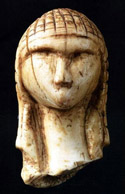Anthropology, Department of

Department of Anthropology: Faculty Publications
Document Type
Article
Date of this Version
12-2019
Citation
Published in Kiva, Vol. 85 No. 4, December, 2019, pp 434–450
DOI: 10.1080/00231940.2019.1690317
Abstract
More than 50 years ago archaeologists identified a high-density of small Puebloan habitations on the Kaiparowits Plateau in southern Utah. Analysis of pottery from these habitations by James Gunnerson and Florence Lister resulted in conflicting interpretations of cultural affiliation. Gunnerson argued for a Virgin affiliation whereas Lister argued for a Kayentan affiliation. Lister’s interpretation triumphed and the Puebloan occupation of the Kaiparowits was attributed to a migration of Kayenta people from the south during the late Pueblo II period. A review of architectural and artifactual evidence fails to support a Kayentan migration. An expansion of Puebloan groups from the west and southwest better accords with the archaeological record on the Kaiparowits Plateau.
Resumen: Hace más de 50 años, arqueólogos identificaron una alta densidad de pequeñas habitaciones Puebloan en la Meseta de Kaiparowits en el sur de Utah. La análisis de la cerámica de estas habitaciones por James Gunnerson y Florence Lister resultó en interpretaciones contradictorias de la afiliación cultural. Gunnerson abogó por una affilición Virgin mientras que Lister abogó por una affilición Kayentan. La interpretación de Lister triunfó y la ocupación Puebloan del Kaiparowits fue atribuyó a una migración de gente Kayenta desde el sur durante el periódo tarde Pueblo II. Una revisión de la evidencia sobre la arquitectónica y los artefactos no respalda una migración Kayentan. Una expansion de los grupos Puebloan desde el oeste y suroeste se adhiere mejor con el registro arqueológico en la Meseta de Kaiparowits.


Comments
Copyright © 2019 Arizona Archaeological and Historical Society; published by Taylor & Francis. Used by permission.